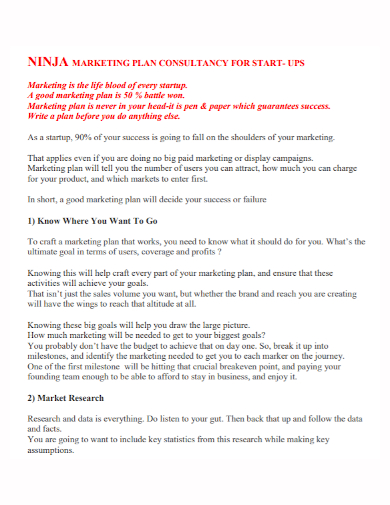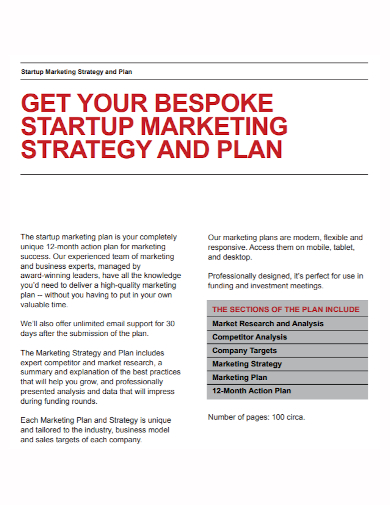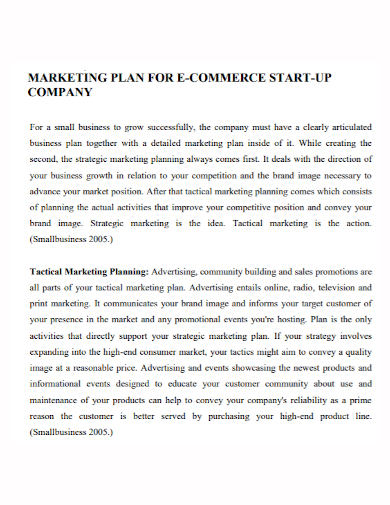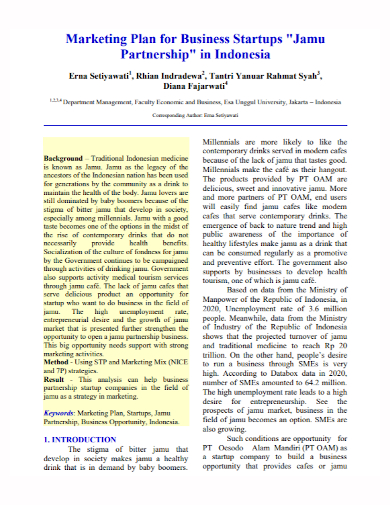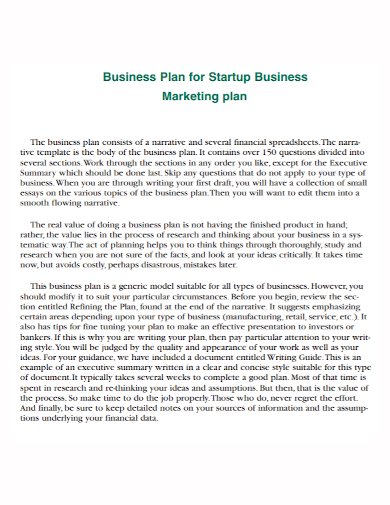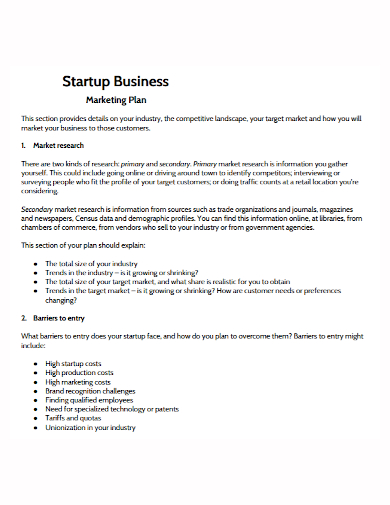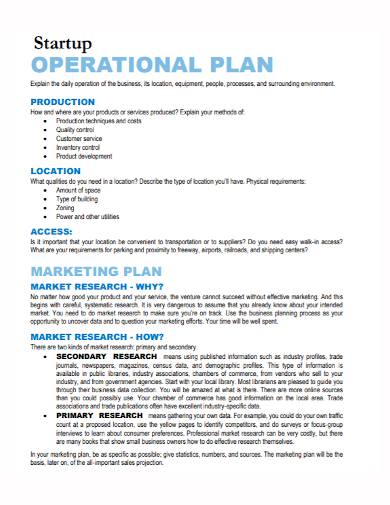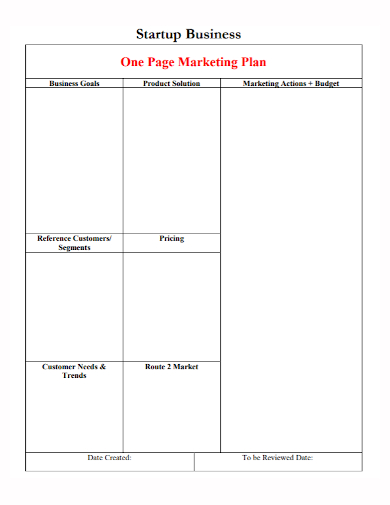It doesn’t have to be expensive to create an effective marketing strategy. All it takes is a little bit of your time, effort, and imagination. These suggestions will help you get started. Why spend a fortune on marketing when you can brainstorm your way to a successful strategy? The best marketing ideas are often simple and low-cost, but they don’t appear out of anywhere. They necessitate a creative, out-of-the-box thinking process. Always keep in mind that building your brand is a never-ending process, so get into the right frame of mind from the start.
10+ Startup Marketing Plan Samples
A marketing strategy is a set of tactics for promoting a startup’s goods and services. While there is no set template, it usually includes a checklist, which is frequently the first step in the marketing process. A marketing plan assists startups in identifying potential customers, channels, and ways to target them with marketing efforts. The success of a business is dependent on a well-thought-out startup marketing strategy that is implemented on time.
1. Startup Marketing Plan Template

2. Startup Sales and Marketing Plan Template

3. Consultancy Startup Marketing Plan
4. Startup Marketing Strategy Plan
5. E-commerce Startup Company Marketing Plan
6. New Product Launch Startup Marketing Plan
7. Startup Business Marketing Plan
8. Sample Startup Marketing Plan
9. Startup Marketing Research Plan
10. Startup Operational Marketing Plan
11. Startup Business One Page Marketing Plan
Developing a Startup Marketing Plan
STEP 1: OUTLINE YOUR STRATEGY
- Set a goal – Your objectives may change depending on how you define success in the early stages of your company. However, many startups’ objectives tend to fall into one of two categories: increasing brand awareness or acquiring new customers. While both categories are important in the development of your startup, prioritizing the goals that make the most sense for you can be beneficial.- Increase brand recognition. It’s critical to introduce yourself to potential customers or clients when starting a new business. You must tell people who you are, what you do, and what distinguishes you from the competition. Your goals—and your marketing strategy—might revolve around getting people to recognize your brand name, logo, or products if you prioritize brand awareness.
– Attract new clients. If you decide to prioritize acquiring new customers, your objectives may include getting new people to sign up for your platform, encouraging them to become active users of your product, or converting existing leads into paying customers. To achieve these objectives, you’ll need to create a marketing strategy that includes eye-catching design, copy, and calls to action that entice people to interact with your company. - Define your target audience – It’s critical for your marketing to reach the right people with the right message, regardless of the type of startup. Take some time to consider who your ideal audience is—or who you want your audience to be—as you plan your marketing strategy.
- Find a place in the market – The most common reason for a startup’s failure is a lack of market demand. Maybe the offered product or service doesn’t solve a problem or isn’t distinctive enough to stand out from the competition. Maybe the company’s focus is too narrow, and the pool of potential customers isn’t large enough to sustain it. Or perhaps it was simply misplaced and never had a chance to reach the intended audience. Take the time to thoroughly research other products on the market and gauge interest from potential customers to give your new startup a better chance of avoiding these common pitfalls. You can start thinking about how you’ll tell your target audience about all the great things you have to offer once you’ve determined there is enough demand to sustain your business.
- Know your budget – Several factors, such as operational costs and revenue forecasts, will influence a startup’s marketing budget. But, regardless of how much money you have to spend on marketing, it’s critical to spend it wisely. Consider your objectives and allocate your marketing budget to the channels that will assist you in achieving them. If a particular channel fails to yield results, don’t be afraid to make adjustments or try something new.
STEP 2: REACH YOUR AUDIENCE USING THE RIGHT CHANNELS
- Website – Websites are versatile marketing tools that can be used at any time to help you communicate with your audience and grow your business.
- Email marketing – Email marketing is a great way to establish a connection with your audience and keep them engaged over time. Add a form to your website (or landing page) to collect visitors’ email addresses, then start sending them updates about your services, content, products, and anything else that might be of interest to them.
- Social media – Social media allows you to quickly communicate with your existing fans, friends, and customers, whether you’re creating and scheduling posts across channels, posting directly or creating ads. It can also help you reach a wider audience and encourage more people to visit your website, shop, or buy your products.
- Content marketing – Content marketing focuses on creating (and sharing) content for your target audiences, such as blog posts, articles, videos, podcasts, and infographics. Unlike other forms of advertising or promotional messaging, this content should provide relevant, valuable information that people are interested in—and want to engage with.
- Offline promotion
STEP 3: MEASURE THE SUCCESS OF YOUR MARKETING CAMPAIGNS
- Track your marketing KPIs – The metrics used to track your progress toward your marketing and business goals are known as KPIs (Key Performance Indicators). Choose KPIs like website traffic, social shares, and new contacts to measure growth in your audience size if your goal is to raise brand awareness. Measure your KPIs against daily or monthly sales and conversion rates if your goal is to acquire more customers and make more money.
- Test, iterate, repeat – You must always listen to your audience, no matter what type of startup you run—even if they only communicate with you through click-throughs, page views, and conversions found in your reports. When something isn’t working, be ready to make changes.
- Learn what is best for your audience – You can improve your strategy based on who your audience is and what works for them with all of this information. Allow your audience to guide your actions, and you’ll be well on your way to meeting your marketing KPIs in no time.
FAQs
Why is it important to define your target market?
To structure your marketing strategy to meet their needs, you must first define your target customer.
What is the importance of conducting keyword research?
Keyword research is an important part of any digital marketing strategy. You must determine the keywords that best describe your company, as well as the keywords that your target audience will use to find you online. These keywords will be used across a variety of platforms, including your website, blogs, social media networks, and advertisements, as part of your startup marketing strategy.
Now that you’ve learned about the elements and channels, it’s time to put your startup marketing strategy into action. Begin by marketing through various social media channels, then focus your search campaigns on a few that are effective.
Related Posts
FREE 7+ Fashion Business Plan Samples in PDF
FREE 10+ Sprint Planning Samples In MS Word | Google Docs | PDF
FREE 10+ Wedding Planning Samples in MS Word | Apple Pages | Powerpoint | PDF
FREE 9+ Monthly Study Planner Samples in PSD | Illustrator | InDesign | PDF
FREE 9+ Sample Curriculum Planning Templates in PDF | MS Word
FREE 10+ Teacher Development Plan Samples in MS Word | Google Docs | Apple Pages | PDF
FREE 10+ Basketball Practice Plan Samples in PDF
FREE 12+ School Business Plan Samples in PDF | MS Word | Apple Pages | Google Docs
FREE 7+ Client Strategic Plan Samples in PDF | MS Word
FREE 11+ Trucking Business Plan Templates in PDF | MS Word | Google Docs | Pages
FREE 7+ Small Hotel Business Plan Samples PDF | MS Word | Apple Pages | Google Docs
FREE 14+ Bakery Business Plans in MS Word | PDF | Google Docs | Pages
FREE 4+ Yearly Lesson Plan Samples in PDF
FREE 50+ Strategic Planning Samples in Google Docs | Pages | PDF | MS Word
FREE 10+ Construction Project Plan Samples in MS Word | Google Docs | Apple Pages | PDF

